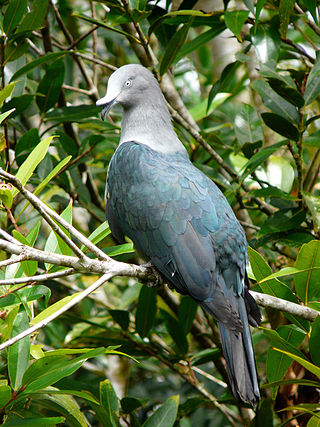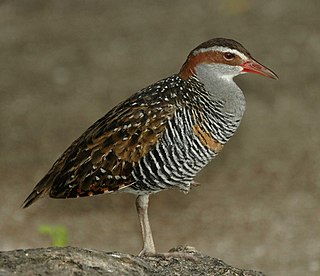
Columbidae is a bird family consisting of doves and pigeons. It is the only family in the order Columbiformes. These are stout-bodied birds with short necks and short slender bills that in some species feature fleshy ceres. They primarily feed on plants, and can be taxonomically divided amongst granivores, that feed mostly on the ground on seeds, and frugivores, that feed mostly on fruits, from branches. The family occurs worldwide, often in close proximity with humans, but the greatest variety is in the Indomalayan and Australasian realms.

The Polynesian sandpipers form the genus Prosobonia. They are small wading birds confined to remote Pacific islands of French Polynesia. Only one species is now extant, and it is rare and little known. This bird is sometimes separated in the genus Aechmorhynchus, restricting the genus to the extinct southern forms.

Henderson Island is an uninhabited island in the south Pacific Ocean. It is part of the Pitcairn Island Group, together with Pitcairn, Oeno, and Ducie Islands. Measuring 9.6 by 5.1 kilometres, it has an area of 37.3 km2 (14.4 sq mi) and is located 193 km northeast of Pitcairn Island, which is the only inhabited island of the group. It has poor soil and little fresh water, and is unsuitable for agriculture. There are three beaches on the northern end and the remaining coast comprises steep cliffs up to 15 m (50 ft) in height. In 1902, it was annexed to the Pitcairn Islands colony, which is now a British Overseas Territory.

The adzebills, genus Aptornis, were two closely related bird species, the North Island adzebill,, and the South Island adzebill,, of the extinct family Aptornithidae. The family was endemic to New Zealand. A tentative fossil species,, is known from the Miocene Saint Bathans fauna.

Dromornis is a genus of large to enormous prehistoric birds native to Australia during the Oligocene to Pliocene epochs. The species were flightless, possessing greatly reduced wing structures but with large legs, similar to the modern ostrich or emu. They were likely to have been predominantly, if not exclusively, herbivorous browsers. The male of the largest species, Dromornis stirtoni, is a contender for the tallest and heaviest bird, and possibly exhibited aggressive territorial behaviour. They belong to the family Dromornithidae, extinct flightless birds known as mihirungs.

The Nuku Hiva imperial pigeon, also known as the Marquesan imperial pigeon or Upe, is a pigeon which is endemic to Nuku Hiva in the Marquesas Islands of French Polynesia. This pigeon is only found in some valleys in the western part of that island.

The Raphina are a clade of extinct flightless birds formerly called didines or didine birds. They inhabited the Mascarene Islands of Mauritius and Rodrigues, but became extinct through hunting by humans and predation by introduced non-native mammals following human colonisation in the 17th century. Historically, many different groups have been named for both the dodo and the Rodrigues solitaire, not all grouping them together. Most recently, it is considered that the two birds can be classified in Columbidae, often under the subfamily Raphinae. The first person to suggest a close affinity to the doves was Johannes Theodor Reinhardt, whose opinions were then supported by Hugh Edwin Strickland and Alexander Gordon Melville.

The blue pigeons are a genus, Alectroenas, of birds in the dove and pigeon family Columbidae. They are native to islands in the western Indian Ocean.

Ducula is a genus of the pigeon family Columbidae, collectively known as imperial pigeons. They are large to very large pigeons with a heavy build and medium to long tails. They are arboreal, feed mainly on fruit and are closely related to the other genus of fruit-eating doves, Ptilinopus. Both genera display brightly coloured plumage, predominantly green, often with contrasting under-parts of purple, orange or red. Some Ducula have prominently swollen ceres. They have large gapes and swallow seeds whole, playing an important role in seed dispersal.

The barking imperial pigeon, also known as Peale's imperial pigeon, is a species of bird in the pigeon family Columbidae. It is endemic to Fiji, where it occurs on most of the medium and large islands.
The Henderson fruit dove, Henderson Island fruit dove or scarlet-capped fruit dove is a species of bird in the family Columbidae.
The Henderson ground dove, or Henderson Island ground dove, is an extinct species of bird in the family Columbidae. It was described from Holocene to possibly Late Pleistocene-aged subfossil remains found on Henderson Island in the Pitcairn Group in 1991. Its relatively small wings suggest it was flightless.
The Henderson imperial pigeon, or Henderson Island imperial pigeon, is an extinct species of bird in the Columbidae, or pigeon family. It was described from subfossil remains found on Henderson Island in the Pitcairn Group of south-eastern Polynesia.
Megavitiornis altirostris is an extinct, flightless, giant stem-galliform bird that was endemic to Fiji, it is the only known species in the genus Megavitiornis. Originally thought to be a megapode, more recent morphological studies indicate a close relationship with Sylviornis of New Caledonia, with both genera belonging to the family Sylviornithidae outside of the Galliformes crown group. It is likely that it became extinct through overhunting shortly after the colonisation of the Fiji Islands by humans.

The St Bathans fauna is found in the lower Bannockburn Formation of the Manuherikia Group of Central Otago, in the South Island of New Zealand. It comprises a suite of fossilised prehistoric animals from the late Early Miocene (Altonian) period, with an age range of 19–16 million years ago.

Hypotaenidia is a genus of birds in the family Rallidae. The genus is considered separate by the IOC and IUCN, while The Clements Checklist of Birds of the World / eBird consider the species to be part of Gallirallus. Since the mid-19th century, when these rather terrestrial birds were recognized to form a genus distinct from the decidedly aquatic Rallus, the validity of Hypotaenidia has been disputed.

The Tuamotu tropical moist forests is a tropical and subtropical moist broadleaf forests ecoregion in the Tuamotu Archipelago of French Polynesia and the Pitcairn Islands.
The Henderson sandpiper is a small extinct Polynesian sandpiper shorebird first described in 2020. It was described from subfossil remains found in 1991 and 1992 on Henderson Island, part of the Pitcairn Islands. It went extinct no earlier than the eleventh century (1000s), soon after humans arrived on Henderson Island. It is possible that these humans brought with them the Polynesian rat, which Polynesian sandpiper populations are very vulnerable to, causing the animal to go extinct.













